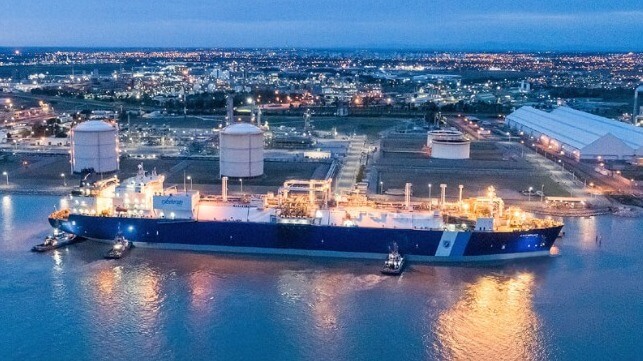Finland’s First FSRU is Ready as Europe Builds Alternate LNG Sources

Finland is preparing for the arrival of its first FSRU in a project organized by the Finnish state-owned gas transmission system operator Gasgrid Finland. The arrival of the vessel further expands Finland’s LNG import operations serving the Baltic region as well as being part of the larger effort across Europe to replace Russian-supplied gas.
Gasgrid Finland reports that construction work in the port of Inkoo on the Gulf of Finland west of Helsinki has been completed for the liquefied natural gas floating terminal. The work began in August 2022 and the contract included the pier and mooring structures and systems needed by the floating storage and regasification unit (FSRU) as well as the construction of a mile of gas pipeline. The goal was to have the FSRU in place and operating before the onset of the hardest part of the winter.
“Completion of the port structures is a really important milestone in the entire LNG floating terminal project,” said Olli Sipilä, Gasgrid Finland’s CEO. “Everything is now in place for Exemplar to safely anchor in the deep harbor in Inkoo in December and connect to Gasgrid’s gas transmission network.”
Gasgrid will be using the Exemplar, an 83,000 dwt FSRU operated by Texas-based Excelerate Energy. The vessel, which has a capacity of 150,900 cbm of gas was loaded with gas originating in Egypt. The vessel departed the anchorage at Gibraltar on December 19. Depending on weather conditions, its arrival in Finland is set for between December 25 and 28.
The 955-foot long Exemplar will be fastened to steel bollards attached to dolphins anchored to the bedrock by a total of more than 112 over 30-meter long bored piles. Gasgrid reports that the structural strengths and tensile strengths are many times those used for normal shipping operations.
Once in place, the first load of LNG will be used both to test the terminal and for the needs of security of supply. The company anticipates that commercial operations will begin by the middle of January. When fully laden, the LNG floating terminal vessel Exemplar holds around 68,000 tons of LNG, which will be fed into Finland’s distribution network and can also be delivered to the Baltic states and even to Poland through the Balticconnector pipeline.
In October, Finland also commissioned its new Hamina LNG terminal located in eastern Finland near the Russian border. Titan completed the first delivery to that terminal in late October offloading a supply of natural gas purchased by Estonia’s energy company Alexela delivered aboard the Optimus, a 6,200 cbm capacity LNG bunker vessel, supplying LNG from the terminal in Zeebrugge, Belgium. UK-based Avenir then completed its first LNG delivery to the terminal in November aboard the Avenir Aspiration, a 4,500 dwt LNG tanker registered in Malta, and a second tanker the Avenir Ascension, another 4,500 dwt LNG carrier also with a capacity of 7,500 cbm, departed Spain on November 18 with the next shipment of LNG to the Hamina terminal. The terminal has a storage capacity of 30,000 cubic meters and regasification and injection services into the Finnish gas transmission network with a daily capacity of 4,800 MWh. It also has an inter-connect to Estonia.
Finland’s FSRU follows the arrival of the first two of six units scheduled to service Germany. German Chancellor Olaf Scholz and other senior government officials marked the opening of the new terminal in Wilhelmshaven on December 17 while Deutsche ReGas has also positioned its first FSRU in the eastern port of Lubmin.
Both Finland and Germany are highlighting the rapid speed at which they were able to develop their FSRU operations. Esa Hallivuori, Head of the LNG Floating Terminal Project at Gasgrid Finland noted the demanding contracting work on port structures and the connecting pipeline saying that an average of 100 construction and design professionals had worked on the project. Chancellor Scholz similarly during the opening in Wilhelmshaven praised how quickly the facility was built highlighting the partnerships including Höegh LNG which owns the FSRU and Uniper which will be operating the terminal. Both projects are designed to support the long-term energy needs of their countries.
